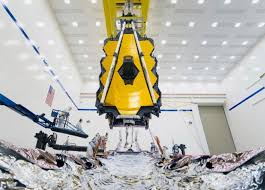Planned to be the successor to the Hubble Space Telescope, the James Webb Space Telescope’s primary scientific mission has four key goals: to search for light from the first stars and galaxies that formed in the Universe after the Big Bang, to study the formation and evolution of galaxies, to understand the formation of stars and planetary systems, and to study planetary systems and the origins of life. These goals can be accomplished more effectively by observation in near-infrared light rather than light in the visible part of the spectrum. Its nominal mission time is five years, with a goal of ten years.
When Is James Webb Telescope expected to launch?
Initially planned for a 2007 launch, the telescope is now expected to launch on March 30th, 2021, on an Ariane 5 rocket from French Guiana. The observatory attaches to the Ariane 5 rocket via a launch vehicle adapter ring which could be used by a future spacecraft to grapple the observatory to attempt to fix gross deployment problems.
It is worth noting that unlike the Hubble Space Telescope, James Webb is not serviceable, and astronauts would not be able to perform tasks such as swapping instruments. This is because the telescope will be located at the L2 Point, which not only limits the service lifetime of the spacecraft, but also makes it unfeasible to service.
Why is James Webb Telescope Delayed?
The delay in the telescope is due to the lack of serviceability and technical firsts. Fitting a telescope of this size requires the telescope to be tested and verified for every step of the way. Getting the telescope onto the rocket and then deploying it is crucial for the entire mission, as a failure in deployment or launch process will result in the failure of the telescope to some degree. Moreover, this telescope is extremely complex to build, which has resulted in a few human errors, causing delays. There have been a plethora of delays with construction, and not that it is complete, NASA wants to take the time to verify that it is indeed going to deploy successfully.
Expected Scientific Discoveries
Although the full list of scientific discoveries is yet to be known, the expected discoveries include studying the first stars and galaxies that formed in the early Universe. This view provided by the telescope will be 100 times greater than the view provided by the Hubble Space Telescope. This will moreover could allow discovery of data relating to the evolution of stars and early galaxies.
Further Reading
https://www.nasa.gov/mission_pages/webb/main/index.html
https://www.space.com/41016-nasa-delays-james-webb-space-telescope-2021.html

Be the first to comment on "James Webb Telescope"